Independence University Capstone: Telemedicine and Healthcare Admin
VerifiedAdded on 2022/08/27
|6
|1326
|24
Capstone Project
AI Summary
This capstone project investigates the significance of telemedicine in healthcare administration. The research explores the benefits and challenges of telemedicine technologies, focusing on data flow, integration, and protection within healthcare systems. The project analyzes how telemedicine can reduce barriers to care, improve patient outcomes, and enhance business performance. The conclusion summarizes the key findings, emphasizing the potential of telemedicine to manage health administrations effectively and reduce communication gaps. Recommendations include providing training to service providers and implementing strategies to address payment and insurance issues. The project also suggests avenues for future research, such as surveys and literature reviews, to further explore the impact of telemedicine on healthcare administration. The project concludes that telemedicine has changed the pace and reach of healthcare administration and has the potential to enhance self-development and self-management of the patients related to the disorders by enhancing the awareness and knowledge about the intervention programs.
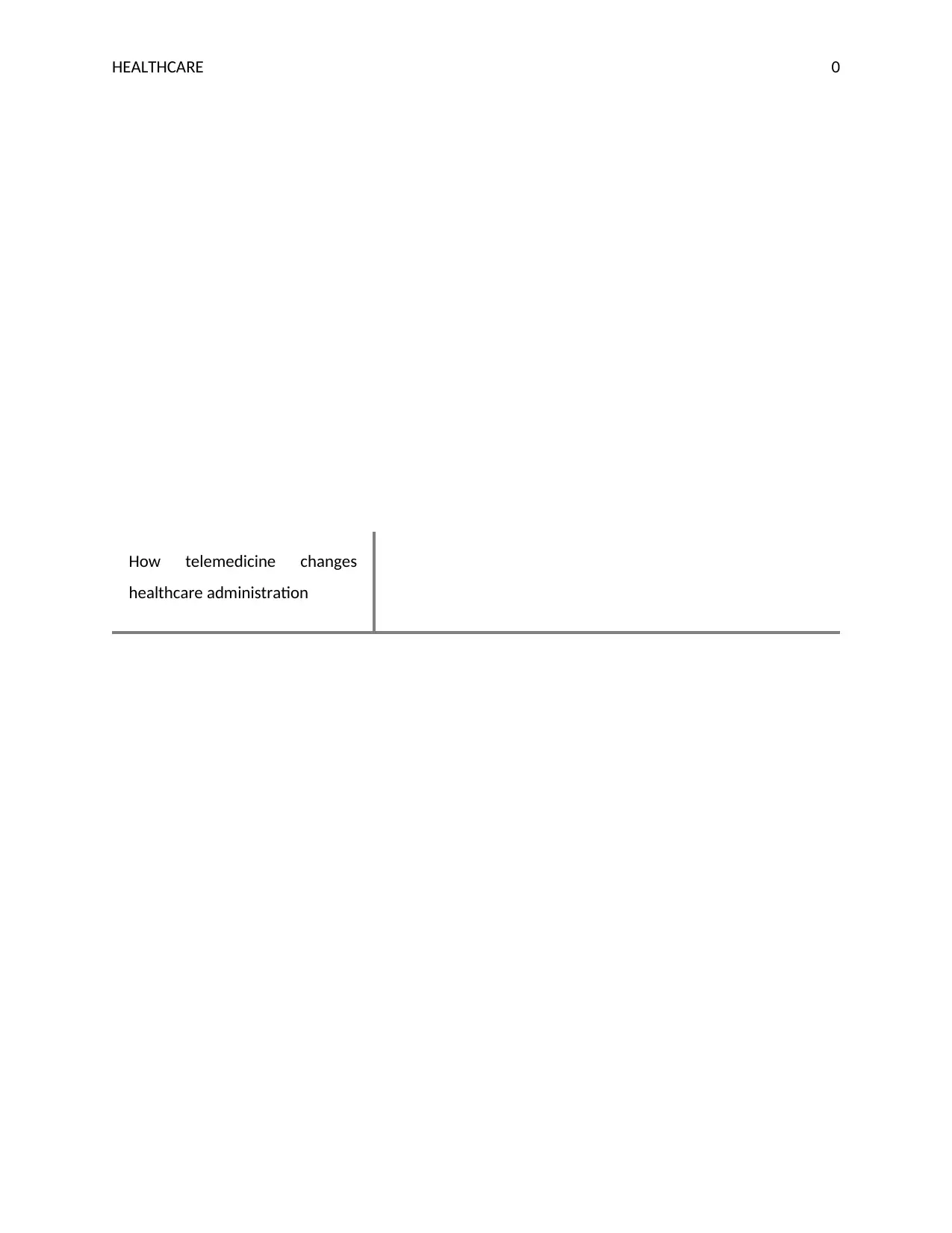
HEALTHCARE 0
How telemedicine changes
healthcare administration
How telemedicine changes
healthcare administration
Paraphrase This Document
Need a fresh take? Get an instant paraphrase of this document with our AI Paraphraser
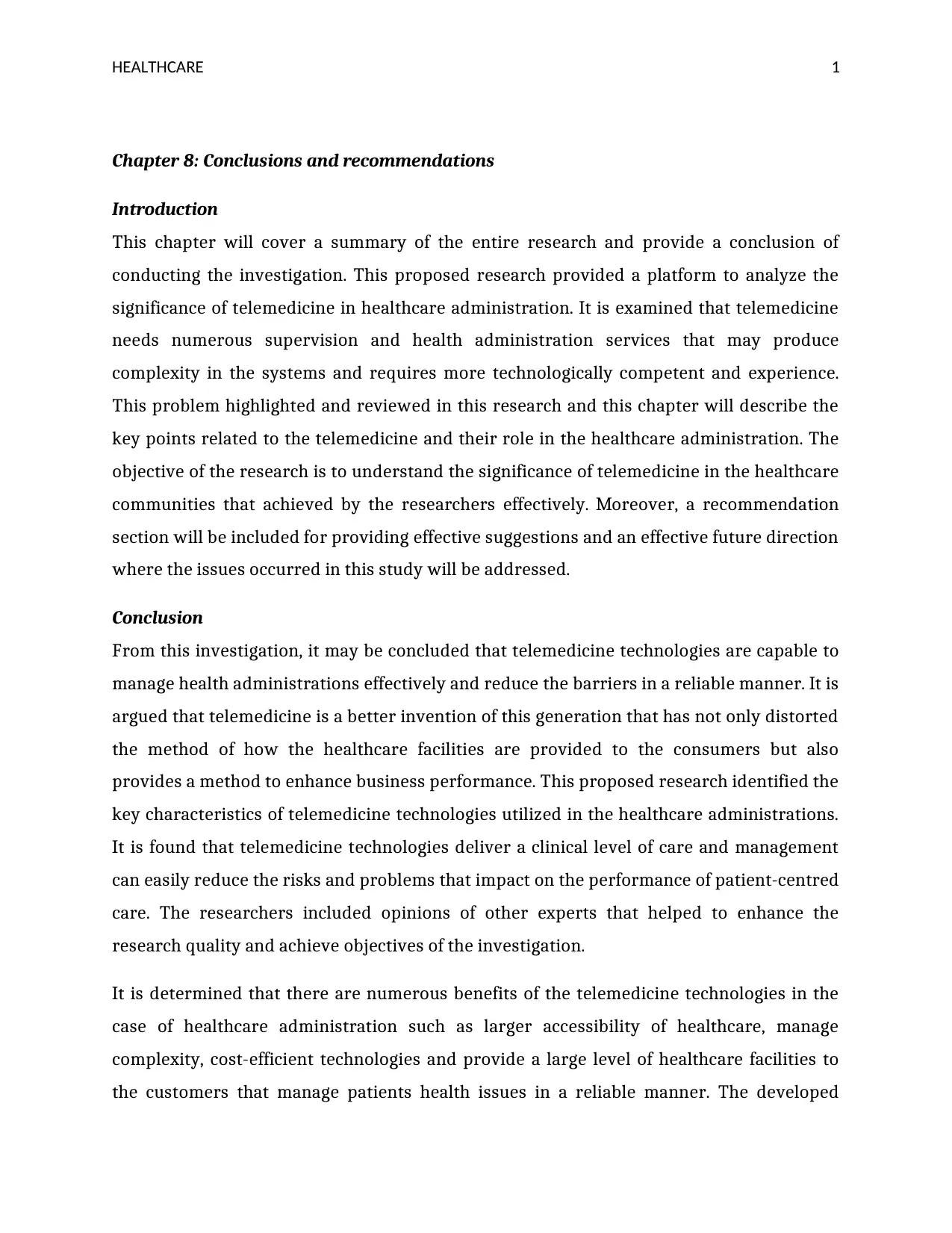
HEALTHCARE 1
Chapter 8: Conclusions and recommendations
Introduction
This chapter will cover a summary of the entire research and provide a conclusion of
conducting the investigation. This proposed research provided a platform to analyze the
significance of telemedicine in healthcare administration. It is examined that telemedicine
needs numerous supervision and health administration services that may produce
complexity in the systems and requires more technologically competent and experience.
This problem highlighted and reviewed in this research and this chapter will describe the
key points related to the telemedicine and their role in the healthcare administration. The
objective of the research is to understand the significance of telemedicine in the healthcare
communities that achieved by the researchers effectively. Moreover, a recommendation
section will be included for providing effective suggestions and an effective future direction
where the issues occurred in this study will be addressed.
Conclusion
From this investigation, it may be concluded that telemedicine technologies are capable to
manage health administrations effectively and reduce the barriers in a reliable manner. It is
argued that telemedicine is a better invention of this generation that has not only distorted
the method of how the healthcare facilities are provided to the consumers but also
provides a method to enhance business performance. This proposed research identified the
key characteristics of telemedicine technologies utilized in the healthcare administrations.
It is found that telemedicine technologies deliver a clinical level of care and management
can easily reduce the risks and problems that impact on the performance of patient-centred
care. The researchers included opinions of other experts that helped to enhance the
research quality and achieve objectives of the investigation.
It is determined that there are numerous benefits of the telemedicine technologies in the
case of healthcare administration such as larger accessibility of healthcare, manage
complexity, cost-efficient technologies and provide a large level of healthcare facilities to
the customers that manage patients health issues in a reliable manner. The developed
Chapter 8: Conclusions and recommendations
Introduction
This chapter will cover a summary of the entire research and provide a conclusion of
conducting the investigation. This proposed research provided a platform to analyze the
significance of telemedicine in healthcare administration. It is examined that telemedicine
needs numerous supervision and health administration services that may produce
complexity in the systems and requires more technologically competent and experience.
This problem highlighted and reviewed in this research and this chapter will describe the
key points related to the telemedicine and their role in the healthcare administration. The
objective of the research is to understand the significance of telemedicine in the healthcare
communities that achieved by the researchers effectively. Moreover, a recommendation
section will be included for providing effective suggestions and an effective future direction
where the issues occurred in this study will be addressed.
Conclusion
From this investigation, it may be concluded that telemedicine technologies are capable to
manage health administrations effectively and reduce the barriers in a reliable manner. It is
argued that telemedicine is a better invention of this generation that has not only distorted
the method of how the healthcare facilities are provided to the consumers but also
provides a method to enhance business performance. This proposed research identified the
key characteristics of telemedicine technologies utilized in the healthcare administrations.
It is found that telemedicine technologies deliver a clinical level of care and management
can easily reduce the risks and problems that impact on the performance of patient-centred
care. The researchers included opinions of other experts that helped to enhance the
research quality and achieve objectives of the investigation.
It is determined that there are numerous benefits of the telemedicine technologies in the
case of healthcare administration such as larger accessibility of healthcare, manage
complexity, cost-efficient technologies and provide a large level of healthcare facilities to
the customers that manage patients health issues in a reliable manner. The developed
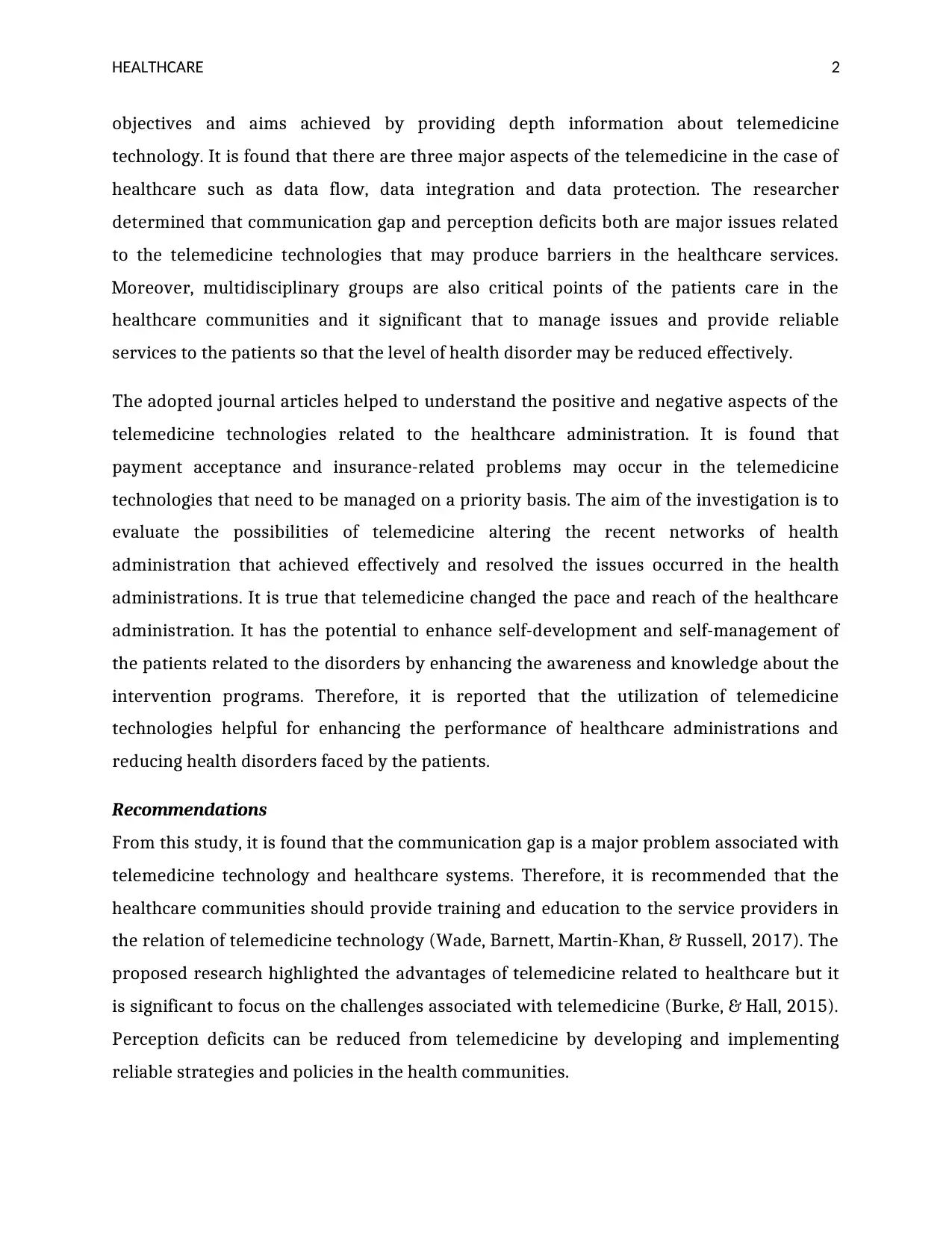
HEALTHCARE 2
objectives and aims achieved by providing depth information about telemedicine
technology. It is found that there are three major aspects of the telemedicine in the case of
healthcare such as data flow, data integration and data protection. The researcher
determined that communication gap and perception deficits both are major issues related
to the telemedicine technologies that may produce barriers in the healthcare services.
Moreover, multidisciplinary groups are also critical points of the patients care in the
healthcare communities and it significant that to manage issues and provide reliable
services to the patients so that the level of health disorder may be reduced effectively.
The adopted journal articles helped to understand the positive and negative aspects of the
telemedicine technologies related to the healthcare administration. It is found that
payment acceptance and insurance-related problems may occur in the telemedicine
technologies that need to be managed on a priority basis. The aim of the investigation is to
evaluate the possibilities of telemedicine altering the recent networks of health
administration that achieved effectively and resolved the issues occurred in the health
administrations. It is true that telemedicine changed the pace and reach of the healthcare
administration. It has the potential to enhance self-development and self-management of
the patients related to the disorders by enhancing the awareness and knowledge about the
intervention programs. Therefore, it is reported that the utilization of telemedicine
technologies helpful for enhancing the performance of healthcare administrations and
reducing health disorders faced by the patients.
Recommendations
From this study, it is found that the communication gap is a major problem associated with
telemedicine technology and healthcare systems. Therefore, it is recommended that the
healthcare communities should provide training and education to the service providers in
the relation of telemedicine technology (Wade, Barnett, Martin-Khan, & Russell, 2017). The
proposed research highlighted the advantages of telemedicine related to healthcare but it
is significant to focus on the challenges associated with telemedicine (Burke, & Hall, 2015).
Perception deficits can be reduced from telemedicine by developing and implementing
reliable strategies and policies in the health communities.
objectives and aims achieved by providing depth information about telemedicine
technology. It is found that there are three major aspects of the telemedicine in the case of
healthcare such as data flow, data integration and data protection. The researcher
determined that communication gap and perception deficits both are major issues related
to the telemedicine technologies that may produce barriers in the healthcare services.
Moreover, multidisciplinary groups are also critical points of the patients care in the
healthcare communities and it significant that to manage issues and provide reliable
services to the patients so that the level of health disorder may be reduced effectively.
The adopted journal articles helped to understand the positive and negative aspects of the
telemedicine technologies related to the healthcare administration. It is found that
payment acceptance and insurance-related problems may occur in the telemedicine
technologies that need to be managed on a priority basis. The aim of the investigation is to
evaluate the possibilities of telemedicine altering the recent networks of health
administration that achieved effectively and resolved the issues occurred in the health
administrations. It is true that telemedicine changed the pace and reach of the healthcare
administration. It has the potential to enhance self-development and self-management of
the patients related to the disorders by enhancing the awareness and knowledge about the
intervention programs. Therefore, it is reported that the utilization of telemedicine
technologies helpful for enhancing the performance of healthcare administrations and
reducing health disorders faced by the patients.
Recommendations
From this study, it is found that the communication gap is a major problem associated with
telemedicine technology and healthcare systems. Therefore, it is recommended that the
healthcare communities should provide training and education to the service providers in
the relation of telemedicine technology (Wade, Barnett, Martin-Khan, & Russell, 2017). The
proposed research highlighted the advantages of telemedicine related to healthcare but it
is significant to focus on the challenges associated with telemedicine (Burke, & Hall, 2015).
Perception deficits can be reduced from telemedicine by developing and implementing
reliable strategies and policies in the health communities.
⊘ This is a preview!⊘
Do you want full access?
Subscribe today to unlock all pages.

Trusted by 1+ million students worldwide
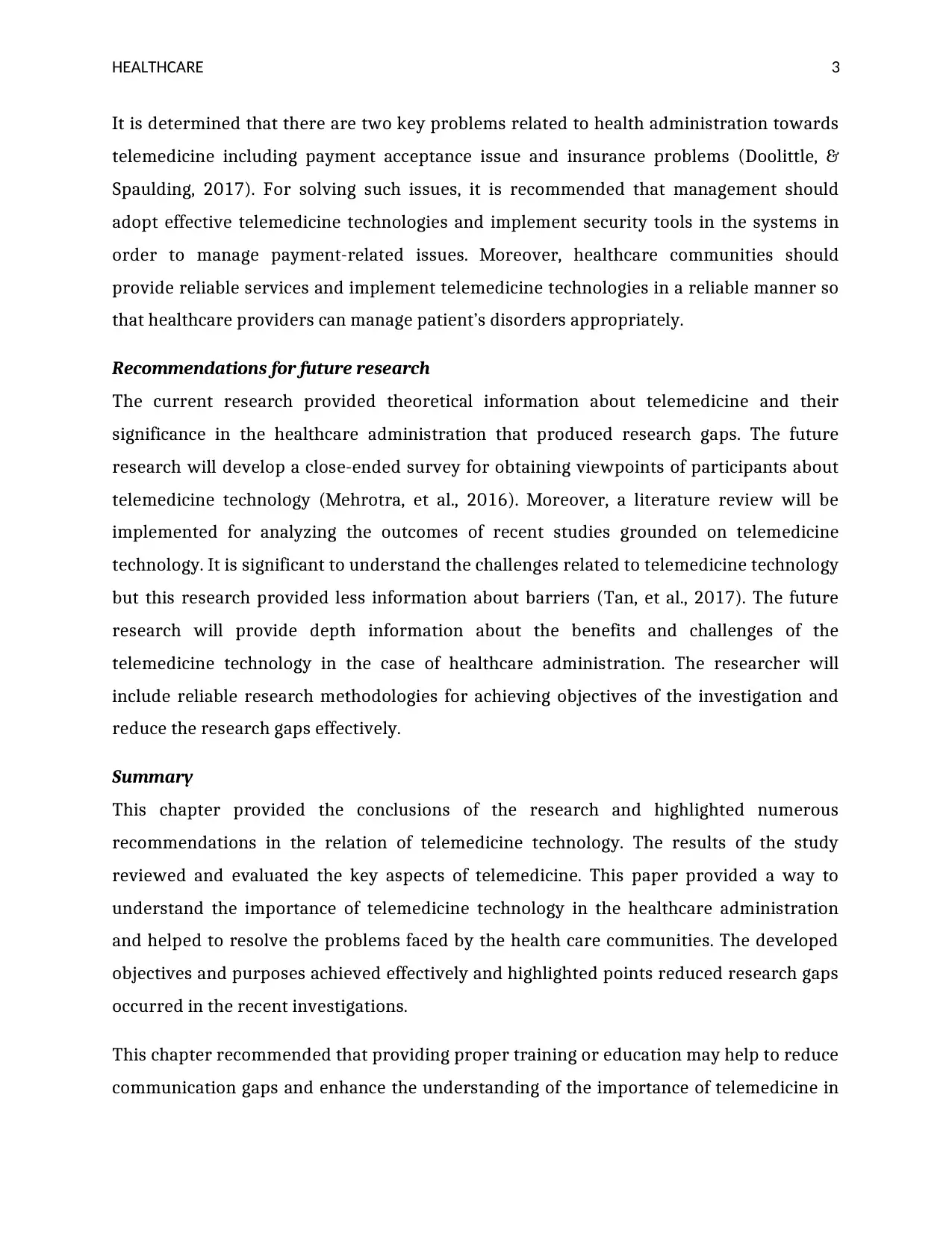
HEALTHCARE 3
It is determined that there are two key problems related to health administration towards
telemedicine including payment acceptance issue and insurance problems (Doolittle, &
Spaulding, 2017). For solving such issues, it is recommended that management should
adopt effective telemedicine technologies and implement security tools in the systems in
order to manage payment-related issues. Moreover, healthcare communities should
provide reliable services and implement telemedicine technologies in a reliable manner so
that healthcare providers can manage patient’s disorders appropriately.
Recommendations for future research
The current research provided theoretical information about telemedicine and their
significance in the healthcare administration that produced research gaps. The future
research will develop a close-ended survey for obtaining viewpoints of participants about
telemedicine technology (Mehrotra, et al., 2016). Moreover, a literature review will be
implemented for analyzing the outcomes of recent studies grounded on telemedicine
technology. It is significant to understand the challenges related to telemedicine technology
but this research provided less information about barriers (Tan, et al., 2017). The future
research will provide depth information about the benefits and challenges of the
telemedicine technology in the case of healthcare administration. The researcher will
include reliable research methodologies for achieving objectives of the investigation and
reduce the research gaps effectively.
Summary
This chapter provided the conclusions of the research and highlighted numerous
recommendations in the relation of telemedicine technology. The results of the study
reviewed and evaluated the key aspects of telemedicine. This paper provided a way to
understand the importance of telemedicine technology in the healthcare administration
and helped to resolve the problems faced by the health care communities. The developed
objectives and purposes achieved effectively and highlighted points reduced research gaps
occurred in the recent investigations.
This chapter recommended that providing proper training or education may help to reduce
communication gaps and enhance the understanding of the importance of telemedicine in
It is determined that there are two key problems related to health administration towards
telemedicine including payment acceptance issue and insurance problems (Doolittle, &
Spaulding, 2017). For solving such issues, it is recommended that management should
adopt effective telemedicine technologies and implement security tools in the systems in
order to manage payment-related issues. Moreover, healthcare communities should
provide reliable services and implement telemedicine technologies in a reliable manner so
that healthcare providers can manage patient’s disorders appropriately.
Recommendations for future research
The current research provided theoretical information about telemedicine and their
significance in the healthcare administration that produced research gaps. The future
research will develop a close-ended survey for obtaining viewpoints of participants about
telemedicine technology (Mehrotra, et al., 2016). Moreover, a literature review will be
implemented for analyzing the outcomes of recent studies grounded on telemedicine
technology. It is significant to understand the challenges related to telemedicine technology
but this research provided less information about barriers (Tan, et al., 2017). The future
research will provide depth information about the benefits and challenges of the
telemedicine technology in the case of healthcare administration. The researcher will
include reliable research methodologies for achieving objectives of the investigation and
reduce the research gaps effectively.
Summary
This chapter provided the conclusions of the research and highlighted numerous
recommendations in the relation of telemedicine technology. The results of the study
reviewed and evaluated the key aspects of telemedicine. This paper provided a way to
understand the importance of telemedicine technology in the healthcare administration
and helped to resolve the problems faced by the health care communities. The developed
objectives and purposes achieved effectively and highlighted points reduced research gaps
occurred in the recent investigations.
This chapter recommended that providing proper training or education may help to reduce
communication gaps and enhance the understanding of the importance of telemedicine in
Paraphrase This Document
Need a fresh take? Get an instant paraphrase of this document with our AI Paraphraser

HEALTHCARE 4
healthcare communities. The future research will conduct a survey through questionnaire
and provided depth information about challenges associated with the telemedicine related
to health administration. The recommendations may help health communities to reduce
barriers occurred in the telemedicine. This chapter summarized the findings of entire
research and reviewed the problems related to telemedicine technology.
healthcare communities. The future research will conduct a survey through questionnaire
and provided depth information about challenges associated with the telemedicine related
to health administration. The recommendations may help health communities to reduce
barriers occurred in the telemedicine. This chapter summarized the findings of entire
research and reviewed the problems related to telemedicine technology.
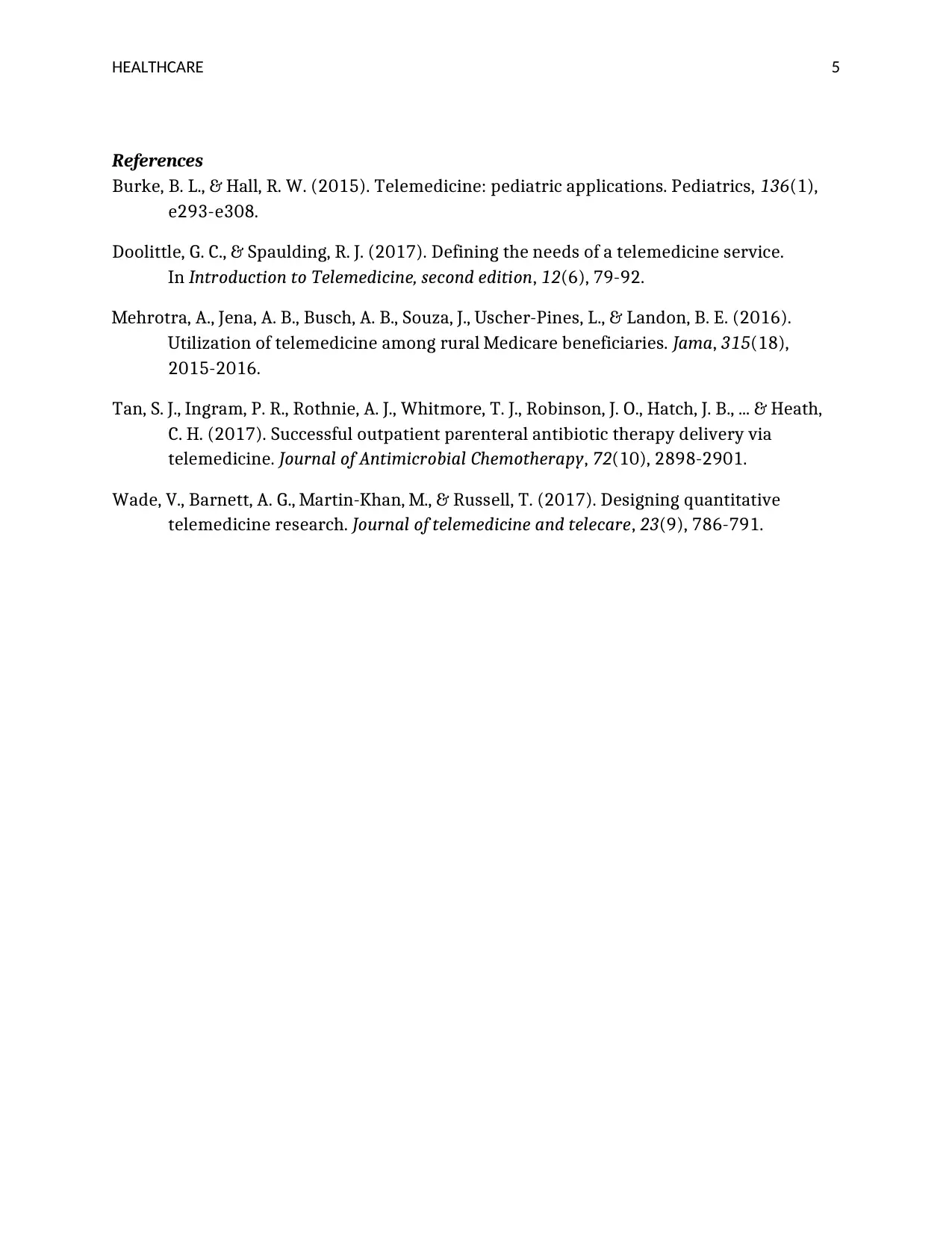
HEALTHCARE 5
References
Burke, B. L., & Hall, R. W. (2015). Telemedicine: pediatric applications. Pediatrics, 136(1),
e293-e308.
Doolittle, G. C., & Spaulding, R. J. (2017). Defining the needs of a telemedicine service.
In Introduction to Telemedicine, second edition, 12(6), 79-92.
Mehrotra, A., Jena, A. B., Busch, A. B., Souza, J., Uscher-Pines, L., & Landon, B. E. (2016).
Utilization of telemedicine among rural Medicare beneficiaries. Jama, 315(18),
2015-2016.
Tan, S. J., Ingram, P. R., Rothnie, A. J., Whitmore, T. J., Robinson, J. O., Hatch, J. B., ... & Heath,
C. H. (2017). Successful outpatient parenteral antibiotic therapy delivery via
telemedicine. Journal of Antimicrobial Chemotherapy, 72(10), 2898-2901.
Wade, V., Barnett, A. G., Martin-Khan, M., & Russell, T. (2017). Designing quantitative
telemedicine research. Journal of telemedicine and telecare, 23(9), 786-791.
References
Burke, B. L., & Hall, R. W. (2015). Telemedicine: pediatric applications. Pediatrics, 136(1),
e293-e308.
Doolittle, G. C., & Spaulding, R. J. (2017). Defining the needs of a telemedicine service.
In Introduction to Telemedicine, second edition, 12(6), 79-92.
Mehrotra, A., Jena, A. B., Busch, A. B., Souza, J., Uscher-Pines, L., & Landon, B. E. (2016).
Utilization of telemedicine among rural Medicare beneficiaries. Jama, 315(18),
2015-2016.
Tan, S. J., Ingram, P. R., Rothnie, A. J., Whitmore, T. J., Robinson, J. O., Hatch, J. B., ... & Heath,
C. H. (2017). Successful outpatient parenteral antibiotic therapy delivery via
telemedicine. Journal of Antimicrobial Chemotherapy, 72(10), 2898-2901.
Wade, V., Barnett, A. G., Martin-Khan, M., & Russell, T. (2017). Designing quantitative
telemedicine research. Journal of telemedicine and telecare, 23(9), 786-791.
⊘ This is a preview!⊘
Do you want full access?
Subscribe today to unlock all pages.

Trusted by 1+ million students worldwide
1 out of 6
Related Documents
Your All-in-One AI-Powered Toolkit for Academic Success.
+13062052269
info@desklib.com
Available 24*7 on WhatsApp / Email
![[object Object]](/_next/static/media/star-bottom.7253800d.svg)
Unlock your academic potential
Copyright © 2020–2025 A2Z Services. All Rights Reserved. Developed and managed by ZUCOL.





